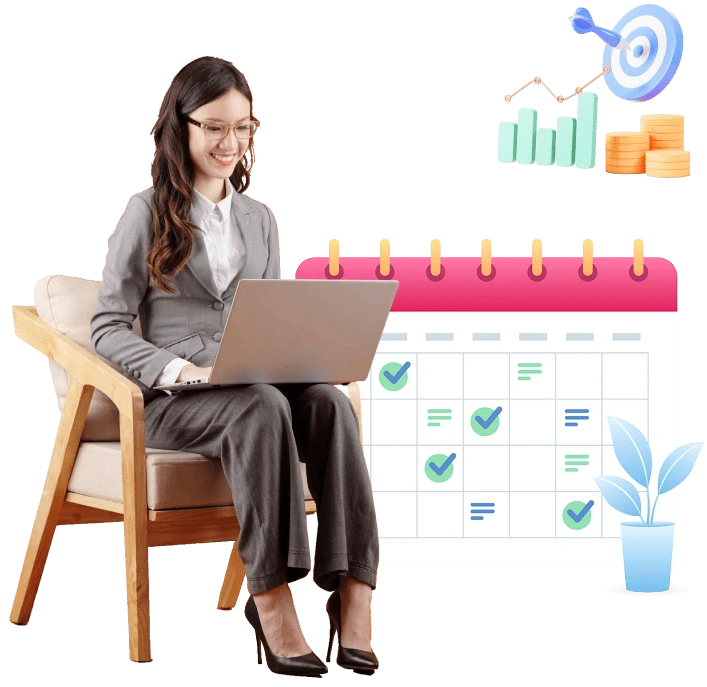Lean-agile leadership is a framework for properly implementing Lean and Agile practices in a large organization. It's primarily made for organizations with a fairly high percentage of complex challenges and where the perspective/context alters frequently. Hence, to be resilient, such companies must make quick decisions about innovation and operation strategies.
Lean-Agile Leadership can also be implemented for organizations that have a high percentage of knowledge work and need sustainable commercial stability. This strategy also nurtures long-term relations with customers, staff, and suppliers. It should be remembered that organizations that adopt the Lean-Agile Leadership strategy will have a network of teams rather than a traditional hierarchy of control and command structure.
Why is Lean-Agile leadership essential?
The managers, executives, and other leaders in an organization will always be held responsible for the success, adoption, and enhancement of Lean-Agile development and the qualities that lead to business agility. They have the authority to continuously change and improve the systems that control an organization's operations.
Furthermore, organization leaders are also responsible for creating a proper environment for individuals to work in so that high-performing Agile teams can thrive and create value for the business. Hence, the need for Leaner ways of operating and thinking among leaders is crucial for team members to get encouragement and obtain proper coaching from the leaders.
It should be known that transforming an organization into a Lean enterprise isn’t easy. It all starts with the leaders motivating and inspiring better working methods within the organization. They will set the stage/example by continuously engaging, coaching, and empowering teams and individuals to reach their full potential via Lean and Agile practices and principles.
Hence, knowledge won't be enough because Lean-Agile leaders should do more than just support the transformation. The idea here is to actively lead the change by guiding & participating in the activities required to understand and thereby constantly optimize the flow of value throughout the organization.
Some of the functions of Lean-Agile leaders are:
1. Organizing individuals & teams around creating value.
2. Identifying queues as well as any excess work-in-progress.
3. Always focus on eliminating delays & waste.
4. Try to eliminate procedures & policies that are demotivating to the organization’s employees.
5. Motivate as well as inspire others.
6. Create a proper culture of relentless improvement.
7. Offer the perfect opportunity for teams to improve themselves
Thus, implementing the Lean-Agile leadership framework can reap the benefits mentioned above.
What are the 3 dimensions of Lean-Agile leadership?
In case you’re wondering ‘what are the 3 dimensions of Lean-Agile leadership?’, then they are as follows:
1. Leading by example
Organizational leaders gain authority by modeling much-needed behaviors for others to follow, inspiring them to include the leader's qualities in their development journey.
2. Mindset & Principles
Leaders can model the expected norm throughout the company by properly coagulating the Lean-Agile way of working into the organization's employees' decisions, beliefs, actions, and responses.
3. Leading change
Leaders should lead the transformation process rather than simply supporting it. They should create a proper work environment, properly prepare the employees, and provide them with the required resources to obtain the desired outcomes.
Differences between traditional and Lean-Agile leadership
Traditional leadership usually focuses on democratic, autocratic, and paternalistic approaches to managing and directing the team. On the other hand, Lean-Agile leadership utilizes transformational, situational, and servant leadership-type approaches.
Hence, it can be concluded that Lean-agile leadership allows for more flexibility instead of following a rigid structure where trying new processes or things is permitted. Flexibility in the work environment helps create a net inflow of ideas, and creativity supports experimentation. Furthermore, there is clear communication and a sense of satisfaction. It should be understood that both of the aforementioned leadership roles utilize different skills and characteristics.
Currently, Lean-Agile leadership is based on multiple principles that help enable leaders & managers to develop the Agile transformation. Some of the crucial principles that are followed in the Lean-Agile leadership framework are:
1. Proper inspiration & motivation
Human beings are like chameleons. They try to develop and adopt skills that they see in their leaders or seniors. Thus, Lean-Agile leaders should always lead their teams by example so that the team members can develop similar skills to those of the leaders. The leaders must inspire their team by first showcasing their qualities.
2. Ideal thinking prowess
Quality thinking, meaningful actions, and innovative ideas can help solve problems. Thus, the Lean-Agile leadership framework offers the flexibility to find new and innovative procedures for issues.
3. Offer constructive & continuous feedback
It should be noted that Agile leadership helps leaders develop proper skills in offering constructive feedback. Constructive feedback makes the feedback meaningful and guides how improvements should be made. Such a process empowers the employees of an organization and, therefore, allows them to obtain the desired outcome creatively.
4. Utilisation of emotions
Human beings have different emotions. The key here is to understand those various emotions within the team and inspire them through empathy & constructive feedback. Agile leaders are responsible for helping the team develop proper skills to manage their own emotions and thus bring positivity to the workplace while making the correct decisions.
5. Creating a collaborative environment
A single person within an organization cannot perform all the tasks, which is why collaboration & teamwork is needed. Both of the aforementioned qualities are responsible for creating the perfect efficiency within the workplace. Team members who work in collaboration with each other will be more likely to achieve success in their journey.
6. Creativity
The good thing about Lean-Agile leadership is that – it never underestimates the place from where creativity & innovation can arrive. Agile leaders always tend to be broad-minded and they work to keep the organization's goal in perspective. Agile leaders also support & allow innovative ideas from any person within the organization, irrespective of the designation or cadre.
Advantages of Lean-Agile Leadership
The primary benefit that can be achieved from a Lean-Agile leadership framework is the sustainable growth of the business. Other merits include:
1. Create human relationships within teams and thereby value them.
2. Better mindfulness as well as responsiveness at each level.
3. Creates an environment of continuous learning.
4. Creates confidence within the team members.
5. Difficulties become easier to tackle with a responsible, organized, and autonomous culture.
Agile environments tend to work best for companies because professionals can contribute, grow, and work together. Hence, the first step towards success is to develop Lean-Agile leadership at every level of the organization.
The framework of the Lean-Agile leadership
1. The Team
In Lean-Agile leadership, teams are used as the operating unit wherever possible. The teams are cross-functional and self-organizing and will be able to deliver the services/products as per the main backlog. They will be designed with internal coherence to operate independently, almost like a small business.
The team concept is taken from the classic scrum team, which can also be generalized to be called the ‘circle’. Circles are always expected to operate using constant feedback, planning, reviewing, and retrospecting. They should also make their work as transparent as possible.
It should be noted that circles will have relationships with other circles, defining how they interact. Moreover, circles can also be scaled up or down based on the main backlog and the work to be done.
2. The Roles
In the Lean-Agile leadership framework, the major roles include the SO, or the Strategy Owner, who is equivalent to the product owner in the scrum. Then there is the OO, or Operations Owner, who is comparable to a scrum master in the scrum. Finally, there's the self-organizing, cross-functional team.
3. The Artifacts
In Lean-Agile leadership, the following set of artifacts can be assumed:
- Circle manifest
- Main backlog
- Tactical backlog
- Improvement backlog
- Relationship Manifest
Conclusion
At the end of the heyday, it can be easily concluded that Agile leadership is a major component in properly managing teams inside an organization. Companies will always prefer and choose professionals with Agile leadership skills for authoritative positions.
The good news is that the values and principles related to Lean-Agile Leadership are relatively easy to learn and few. Hence, it makes sense for interested individuals to hop onto the SAFe Lean-Agile Leadership certification without any second thoughts. Simpliaxis offers comprehensive training programs in Lean-Agile leadership, empowering leaders to master the skills and principles essential for navigating complex challenges effectively. Simpliaxis offers a comprehensive Certified Agile Leader® (CAL-I™) Training that equips leaders with the skills and knowledge necessary to lead Agile transformations effectively. This certification is designed for those who aspire to enhance their leadership capabilities in an Agile environment.






















